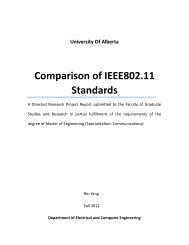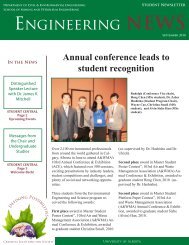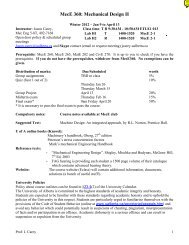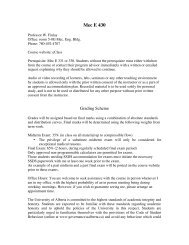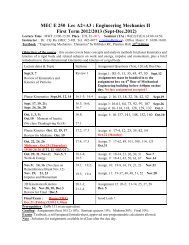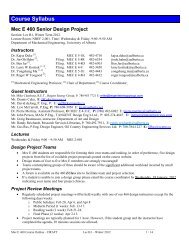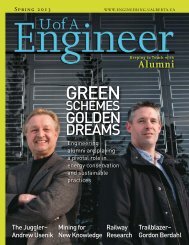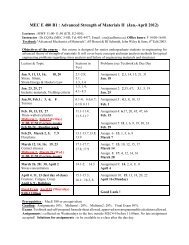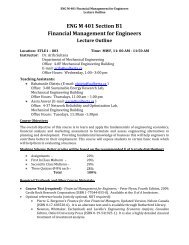Download - Faculty of Engineering - University of Alberta
Download - Faculty of Engineering - University of Alberta
Download - Faculty of Engineering - University of Alberta
You also want an ePaper? Increase the reach of your titles
YUMPU automatically turns print PDFs into web optimized ePapers that Google loves.
While at the U <strong>of</strong> A, Su became interested<br />
in research. As project chairman <strong>of</strong> the IEEE<br />
students’ branch, he led his team to receive a<br />
Vincent Bendix Award for their proposal to<br />
build a collision avoidance radar. However,<br />
the idea was ahead <strong>of</strong> its time. Only today,<br />
nearly 40 years later, are such radars becoming<br />
technologically feasible, says Su. Even so,<br />
the students managed to build the circuits.<br />
After graduating from the U <strong>of</strong> A, Su<br />
entered graduate school at the California<br />
Institute <strong>of</strong> Technology, studying electrical<br />
engineering. He had finished his master’s,<br />
completed his PhD qualifying exams,<br />
and was on the verge <strong>of</strong> starting his work<br />
on integrated optics with Dr. Amnon Yariv,<br />
an authority on lasers and optics. Then,<br />
Singapore suddenly requested he return to<br />
the country. It might have been a missed<br />
opportunity—Yariv went on to start an<br />
optical device company that he later sold to<br />
Lucent for $2 billion—but Su tries not to<br />
dwell on this fact.<br />
Back in Singapore, Su started working on<br />
radars and electronic warfare with the<br />
Ministry <strong>of</strong> Defence, which was more interesting<br />
work than the normal compulsory<br />
military service. In those days, radar was<br />
mostly analog. So, when Su had a chance to<br />
NTU Campus is a sight to behold. Above,<br />
the elegant Nanyang Auditorium; below,<br />
a bird’s-eye-view along the North Spine<br />
Complex.<br />
do his PhD in 1980, he went to Stanford<br />
<strong>University</strong> and focused on signal processing<br />
relevant to radar and communications.<br />
When he returned to the defence research<br />
and development laboratory in Singapore<br />
three years later, he tried to squeeze in whatever<br />
time he could on his own research. But<br />
he devoted most <strong>of</strong> his effort to boosting the<br />
laboratory’s reputation for innovation,<br />
allowing Singapore to collaborate with other<br />
countries on research projects.<br />
He also worked as an adjunct engineering<br />
pr<strong>of</strong>essor at the National <strong>University</strong> <strong>of</strong><br />
Singapore in 1991, and later taught management<br />
<strong>of</strong> technology at the <strong>University</strong> <strong>of</strong><br />
Singapore Business School from 1998 to<br />
2000. He organized his laboratories to<br />
become a not-for-pr<strong>of</strong>it corporation, DSO<br />
National Laboratories, serving as chief executive.<br />
And he somehow found time to work<br />
in a post-graduate program in business<br />
administration at the <strong>University</strong> <strong>of</strong> Singapore<br />
and Harvard Business School.<br />
Su was also appointed deputy secretary<br />
(technology) in the Ministry <strong>of</strong> Defence,<br />
heading the procurement, IT, construction<br />
and R&D funding arm, the Defence<br />
Technology Group. He would stay with the<br />
ministry until 2002, when Nanyang<br />
Technological <strong>University</strong> began a worldwide<br />
search for a new president. His name was<br />
submitted and, in July <strong>of</strong> that same year, Su<br />
was <strong>of</strong>fered the job.<br />
Despite earning an international reputation<br />
in the field <strong>of</strong> defence, Su decided to<br />
return to academia. Since the inception <strong>of</strong> his<br />
term, he has raised the pr<strong>of</strong>ile <strong>of</strong> NTU, made<br />
up <strong>of</strong> 20,000 undergraduates and 8,700<br />
graduate students from around the world.<br />
The institution is ranked among the top 25<br />
technology universities globally.<br />
Su says his work with the government and<br />
as a researcher taught him that the quickest<br />
way between two points is not necessarily<br />
the straight line. “I learned a lot more<br />
about human behaviour and especially<br />
managing outstanding engineers and scientists,”<br />
he says. “It was useful preparation for<br />
my role as president <strong>of</strong> NTU, but there was<br />
much more to learn. Academia is very different<br />
from corporate life, and academics are<br />
much more complex than corporate engineers<br />
and scientists.”<br />
“For a few weeks, the four <strong>of</strong><br />
us spent our days working<br />
under the scorching sun,<br />
hoeing unending rows <strong>of</strong> sugar<br />
beets. The pay we received<br />
was a pittance, but the<br />
experience was something<br />
I found worthwhile, as many<br />
<strong>of</strong> the migrant workers at<br />
the job were aboriginals<br />
and I got to know them well.”<br />
— GUANING SU<br />
Next, Su would like to continue laying the<br />
groundwork for a “truly great university” by<br />
rebuilding the university governance systems<br />
and processes, and by recruiting innovative<br />
and creative people. Singapore is in a unique<br />
position along two axes, Su says—on one<br />
side, the cultural fusion between East and<br />
West, and on the other, the research and<br />
innovation needed to create a knowledgebased<br />
economy.<br />
“I would like to build our university into a<br />
central driver in both these axes and in doing<br />
so, leave a legacy for future generations,” he<br />
says. “My present role as president <strong>of</strong> NTU is<br />
a great challenge. My goal is to completely<br />
transform it from a large, teaching-dominant<br />
engineering university to one <strong>of</strong> the outstanding<br />
universities in the world, with great<br />
research and teaching in a wide range <strong>of</strong><br />
disciplines. This will take time to accomplish<br />
and we are just in the middle <strong>of</strong> the process.”<br />
Looking back on his career, Su has much<br />
to be proud <strong>of</strong> but he points to his 30 years<br />
in the defence community where his contributions,<br />
many <strong>of</strong> them classified, help make<br />
his country more secure. “This provides a<br />
strong foundation on which to build political<br />
stability, prosperity and happiness.”<br />
Su credits the U <strong>of</strong> A for his own strong<br />
foundation, helping him to build the sound<br />
fundamentals needed to excel in his graduate<br />
study and subsequent career. “To this day,<br />
returning to Edmonton gives me a warm<br />
glow from inside—even if it’s 40 below<br />
outside. I made lifelong friends and the memory<br />
there lasts a lifetime.”<br />
Phoebe Day is an Edmonton-based<br />
freelance writer.<br />
Spring 2009 U <strong>of</strong> A Engineer 25




